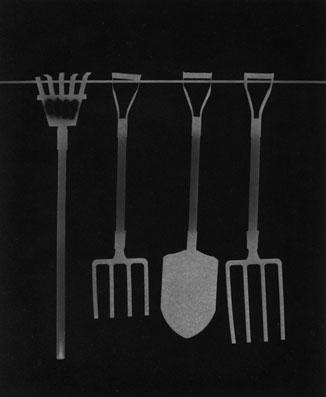Early photographic science leading to the photogram (prior to fixing the image)
There were countless early experimental attempts to find suitable photosensitive materials to produce what were originally called “photogenic drawings”. These attempts pre-dated the use of cameras and were concerned with coating commonly available materials such as glass, metal, paper and even leather with light-sensitive chemicals. Even before this, the Phoenicians are reported to have developed a way to make photograms by drawing on translucent papyrus and transferring the drawing to another piece of papyrus using light from the sun.
The first chemically photographic process can be considered a photogram. This was an accidental discovery, in 1725, where Johann Heinrich Schultze (1687-1744), a German physicist who was also a professor of anatomy and medicine at the University of Altdorf, found that silver nitrate impregnated on gypsum in a jar, when left exposed to sunlight, turned dark on the side facing the window. After exposure, if the bottle was shaken, fresh silver nitrate replaced the exposed material near the glass surface. Schultze first demonstrated that this action was caused by light and not by heat. This experiment was followed by his experiment in which he cut letters from paper, arranged them into words and wrapped them around the jar, and demonstrated the intentional action of light to achieve the photographic photogram without the use of a focusing lens. [Adolfo Martinez in PhotoVision 22, a quarterly publication, 1981, Arte y Proyectos Editoriales, S. L. p4-5.]. (See a different interpretation in [Jean S. Tucker, Light Abstractions: A Photographic Exhibition, University of Missouri-St. Louis, 1980 (exhibition catalogue) page 6]. It should be noted that Schultze's experiments into light sensitivity used a dry mixture of silver nitrate with the inert chalk powder. This is distinctly different from the historical descriptions of mixing aqueous solutions of various materials and coating various substrates, allowing them to dry and then exposing the coated materials.
Schultze, who was a professor of anatomy at the University of Altdorf, at the time reported on this light sensitivity of silver salts when he published “Scotophorus per phosphoro inventus” (1927) and thus invented the cornerstone of photographic chemistry and what we today refer to as the photogram. [from History of the Photographic Method www.allerli.gmxhome.de/history.htm] Upon reading about some early studies of phosphorescent materials, Schultze added some nitric acid to chalk as described in the earlier report, however, the nitric acid probably had some silver in it from an earlier experiment. The chalk darkened upon exposire to light. He then proceeded to investigate the reason for the change in color and found that it was not caused by heat, nor the substrate since he used white lead, magnesia and other substrates. [from H. Chapman Jones, Photography of Today, 1913] Schultze’s experiment failed to result in a permanent image because exposure to light continued to change the unfixed photogram, however, this experiment showed the potential for the action of light to capture the result of a chemical reaction to produce an intended image. [Adolfo Martinez in PhotoVision 22, a quarterly publication, 1981, Arte y Proyectos Editoriales, S. L., p5].
Although Schultze used silver nitrate as early as 1725 to produce an image, many iron and other non-silver methods were developed before the commercial use of silver salts came into common use as we know them today. These non-silver methods have become know as alternative methods today, however, this was not the case earlier in photographic history.
Thomas Wedgewood (1771-1805), was the son of the potter and industrialist, Josiah Wedgewood (1730-1795), born in Etruria. Thomas Wedgewood was a chemist and physicist and, by experimenting with chemicals in his father’s shop was able to produce only transient images. In 1790-1795 he used light to record images on chemically sensitized material, especially glass. In 1802, he presented along with Sir Humphrey Davy, to the Royal Institution of Great Britain a paper “An Account of Method of Copying Paintings upon Glass, and making Profiles by the Agency upon Nitrate of Silver”. This was in essence a method of making photogram images on paper impregnated with silver nitrate – a process not dissimilar with techniques used today. He is known to have produced designs on leather, glass and ceramic items using light and heat to change chemical substances. These images, although temporary, can be considered photograms.
Wedgewood was quoted to have said “no attempts have been made to prevent the uncolored parts of the copy or profile from being acted upon by light have yet been successful”. They have discovered but half the spell and the images could not be fixed. Wedgewood called these images “sun prints”, a term that has survived to this day. Some of his experiments included placing lace on photosensitive paper and produced an image in which the tones were reversed in tone that represents the negative as we now refer to it. Wedgewood’s experiments led him to conceive of the idea that light acts toward “understanding the method by which the outlines and shades of painting on glass may be copied, or profiles procured, by the agency of light” [Batchen, Geoffrey, Burning With Desire--The Conception of Photography. Cambridge, Massachusetts: The MIT Press, 1997]. His work failed to produce permanent images due to his inability to fix the image [Meteyard, Eliza. The Life of Josiah Wedgwood, London. London: Hurst & Blackett Publishers, 1865]. In this regard, Humphrey Davy wrote “The copying of a painting, or the profile, immediately after being taken, must be kept in an obscure place. It may indeed be examined in the shade, but, in this case, the exposure should be only for a few minutes, by the action of candles or lamps, as commonly employed it is not sensibly affected.” Wedgewood's experiments on the projecting of light onto objects in contact with a photosensitive substrate, be it glass or leather, represent seminal early demonstration of the fundamentals of the photogram method.
